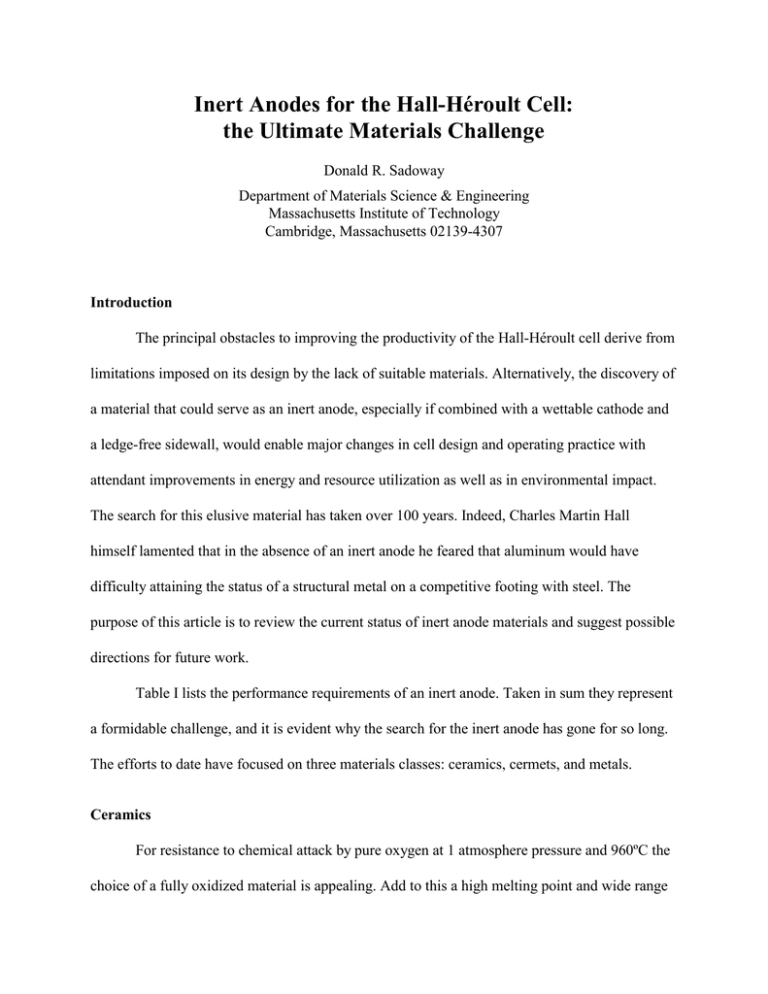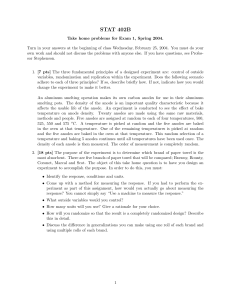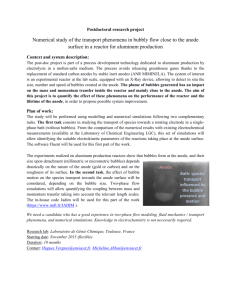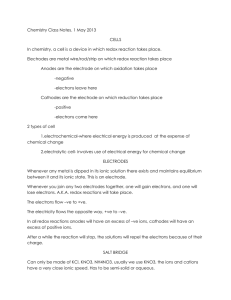Inert Anodes for the Hall-Héroult Cell: the Ultimate Materials Challenge
advertisement

Inert Anodes for the Hall-Héroult Cell: the Ultimate Materials Challenge Donald R. Sadoway Department of Materials Science & Engineering Massachusetts Institute of Technology Cambridge, Massachusetts 02139-4307 Introduction The principal obstacles to improving the productivity of the Hall-Héroult cell derive from limitations imposed on its design by the lack of suitable materials. Alternatively, the discovery of a material that could serve as an inert anode, especially if combined with a wettable cathode and a ledge-free sidewall, would enable major changes in cell design and operating practice with attendant improvements in energy and resource utilization as well as in environmental impact. The search for this elusive material has taken over 100 years. Indeed, Charles Martin Hall himself lamented that in the absence of an inert anode he feared that aluminum would have difficulty attaining the status of a structural metal on a competitive footing with steel. The purpose of this article is to review the current status of inert anode materials and suggest possible directions for future work. Table I lists the performance requirements of an inert anode. Taken in sum they represent a formidable challenge, and it is evident why the search for the inert anode has gone for so long. The efforts to date have focused on three materials classes: ceramics, cermets, and metals. Ceramics For resistance to chemical attack by pure oxygen at 1 atmosphere pressure and 960ºC the choice of a fully oxidized material is appealing. Add to this a high melting point and wide range D.R. Sadoway, JOM, 53 (5), 34-35 (2001). page 2 of electrochemical stability, and it is easy to see why ceramics have received attention. Almost exclusively, oxides have been chosen as candidate materials. Unfortunately, most oxides exhibit unacceptably low electronic conductivity and unacceptably high solubility in Hall bath. Low conductivity leads to problems because an anode made of such a material will incur a large voltage drop with undesirably high joule heating. High solubility leads to problems because any oxide nobler than alumina (and almost everything is nobler than alumina) will be electrolyzed along with it, thereby contaminating the aluminum metal product. Furthermore, bulk ceramics possess poor thermal shock resistance and, in general, are not mechanically robust. Beyond this, ceramics pose operational challenges such as the electrical connection to the bus and cell startup. Finally, the issue of scalability has not been adequately addressed, i.e., while pencil-sized specimens have been shown to work in laboratory cells, efforts to make industrial-scale anodes of monolithic ceramics have been thwarted by their poor thermomechanical properties. At one time tin oxide was the focus of attention owing to its high electronic conductivity. Unfortunately, tin oxide is rather soluble in Hall bath. Nobler than aluminum, tin codeposits with it and contaminates the metal product. While, in principle, it is possible to remove the tin subsequently, the cost of this additional unit operation makes the use of tin oxide anodes unattractive. Other ceramics that have been tested include semiconducting oxides such as ferrites, spinels, and certain perovskites. In spite of efforts to improve their electrical properties by doping, these materials fail to exhibit adequate conductivity. At the same time, they dissolve in Hall bath, and so when the cell is operated with an anode of such material, the aluminum metal product contains unacceptably high levels of base metal. D.R. Sadoway, JOM, 53 (5), 34-35 (2001). page 3 Cermets Cermets are composite materials consisting of a ceramic phase and a metallic phase. The attractiveness of cermets is their putative ability to combine the features of ceramics and metals, namely, chemical inertness and electronic conductivity. Cermets for use as inert anodes have predominantly consisted of a metal dispersion within a ceramic matrix. The ceramic matrix provides bulk and offers chemical stability, while the metal confers conductivity and toughness. The result is that some of the shortcomings of monolithic ceramics remain, e.g., solubility in Hall bath with attendant contamination of aluminum metal product, not to mention the thermomechanical problems and scalability issues cited above in connection with monolithic ceramics. To address the solubility issue some have proposed saturating the electrolyte with alumina in recognition of the fact that oxide solubility scales inversely with alumina concentration. While it is possible to operate a cell with so-called saturated bath, feeding such a cell is problematic and would likely require the use of a separate chamber from which the electrolyte would have to be pumped to the electrolysis cell. Also, in the cermet, while the presence of the metal dispersion raises the electrical conductivity, it is still lower than that of a conventional carbon anode. Furthermore, cell startup with a cermet anode is problematic: contact between the anode and carbon block at elevated temperature can result in carbothermic reduction of the ceramic phase. Finally, the long-term stability of such a dual-phase microstructure with its extremely high interfacial area given the severe service environment, i.e., high d.c. current at elevated temperature, is questionable. Coarsening (a process by which the average particle size of the metal dispersion increases by the disappearance of smaller particles and the growth of larger particles) and electromigration (diffusion assisted by the action of electric current) are two mechanisms that over the long term can lead to destruction of the metal dispersion with D.R. Sadoway, JOM, 53 (5), 34-35 (2001). page 4 degradation of the electrical and mechanical properties of the anode. The pre-eminent cermet material is that developed by Alcoa: a metallic dispersion of copper alloy in a ceramic matrix of nickel ferrite. While the company has reported successful operation of laboratory cells with cermet anodes (a feat verified by other workers) and has claimed to be operating an industrial cell fitted with an inert anode, the only reports in the literature of efforts to deploy cermet anodes at the industrial scale recount inability to produce metal that meets purity specification as well as catastrophic failure of the anodes themselves due to thermal shock. Unfortunately, under certain operating conditions, composite materials can be seen as combining not only the desirable properties of two materials, but also their undesirable properties. Metals Easily meeting the majority of the requirements listed in Table I, metals boast superior electrical and thermomechanical performance to that of the carbon anode currently in use: very high electronic conductivity combined with excellent thermal shock resistance and mechanical robustness. In addition, metals are easy to fabricate and present fewer difficulties in service, e.g., connecting to the bus is trivial. Chemical and electrochemical stability are conferred by a surface film comprising alumina thick enough to prevent attack of the underlying metal either by Hall bath or oxygen and thin enough to allow electronic current to flow with minimal resistance. Thus, in effect, “metal anodes” are cermets but with a decidedly different microstructure from that described in the previous section. Clearly, the main concern is the stability of the surface film. If it becomes too thin or disappears, the underlying metal will be attacked. If the film grows too thick, its electrical resistance will increase and cause the cell voltage to rise unacceptably. An example of this type of anode material is aluminum bronze: copper containing aluminum in the D.R. Sadoway, JOM, 53 (5), 34-35 (2001). page 5 amount of 7 - 15% by weight. The free energy of formation of alumina is so much more negative than that of copper oxide that a thin surface film forms consisting of alumina which protects the bulk of the electrode from attack while allowing current to flow. More important is the fact that this surface film is self repairing in service, i.e., if the film is lost or damaged, it can reform: aluminum in the alloy can react with oxygen evolving on the anode surface. Hence, the surface film is not to be confused with a coating but instead viewed as a reaction layer. This reaction layer is dynamically stable in service. It responds to the local chemistry, electrochemistry, and thermomechanical conditions. Also, should the surface film be attacked, the alumina that dissolves in the electrolyte will not contaminate the metal product. At MIT, a laboratory cell fitted with anodes of various copper – aluminum alloys ran for hours producing aluminum and oxygen. Cell voltage remained constant. The presence of oxygen in the anode gas was confirmed by oxygen sensor. In the best instances, the aluminum contained copper impurity below the threshold of detection of EDAX (~0.1%). On other occasions, the anode failed catastrophically and the aluminum was badly contaminated with copper. Two points are particularly noteworthy: first, in these experiments the electrolyte was not saturated with alumina; secondly, the metal anode was capable of operation over a very wide range of current density, i.e., from 0.25 to 2.4 A/cm2. Other Materials Approaches Coatings. Coatings have also been proposed as a means of protecting the substrate. The most notable example of recent years is cerium oxyfluoride (CEROX) from the DeNora group of companies, Eltech and Moltech. Concerns include the mismatch between the substrate and the D.R. Sadoway, JOM, 53 (5), 34-35 (2001). page 6 coating which results in cracks that allow electrolyte penetration. Various barrier layers have been suggested. Even so, the presence of cerium in the electrolyte results in its codeposition with aluminum which must be purified in a subsequent unit operation. To date the industry has not shown its willingness to bear the cost of this additional step. Low-ratio Bath. While, strictly speaking, not a materials approach, low-ratio bath comes up in discussions of inert anodes in the context of an enabler. Hall bath consists primarily of cryolite (Na3AlF6) containing excess AlF3 in the amount of about 10% by weight. While other things are added such as CaF2 and, of course, alumina, the concentration of AlF3 is an important parameter and is expressed by the term, bath ratio (BR), which is the ratio of NaF/AlF3 by mass. So, for example, pure cryolite can be expressed as (NaF)3·AlF3 which is equivalent to BR = 1.5. Modern smelters operate at BRs in the range 1.1 to 1.4. A look at the Na3AlF6 - AlF3 phase diagram reveals a deep eutectic trough at 685ºC and BR = 0.56. The question of operating a Hall cell at, say, 750 - 800ºC has been raised. The assumed benefits include a lower rate of chemical attack of cell components which is thought to be advantageous for the sustainability of certain candidate inert anodes. Unfortunately, temperature also affects the kinetics of alumina dissolution, and so there are reservations about feeding such a cell. Also, control of temperature requires careful thermal management, and to reduce heat generation would require either operation at lower current (economically unfavorable) or reducing the anode-cathode distance (technically challenging). Current Status and Future Prospects The most recent review of the status of inert anodes was conducted by a team of experts assembled for this purpose by the Center for Research and Technology Development of the D.R. Sadoway, JOM, 53 (5), 34-35 (2001). page 7 American Society of Mechanical Engineers (ASME) at the request of the Office of Industrial Technology of the U.S. Department of Energy (contract DE-FC07-98ID13652). The report was issued in July, 1999. The team, known as the Technical Working Group, declared that no fully satisfactory material has been found. In its assessment of previous work the Technical Working Group classified it according to the following scheme: * technical dead-ends * bench-scale successes * unaffordable solutions. Recommendations for future research and development advised the following: * take a systems approach * maintain current standards of metal quality * follow a “gated” scaling approach * encourage industry consortia to share costs and lessen risks * set materials priorities As part of the exercise to recommend future action, members were asked to rank materials classes in order of likelihood of success. Interestingly, metals ranked first, cermets ranked a distant second, and no one chose ceramics. As a longtime advocate of the use of metal anodes, the author, who was also a member of the Technical Working Group, concurs. Neils Bohr once said, “Prediction is very hard… particularly of the future.” So, what, then, are the prospects for the delivery of an inert anode? In the opinion of this author, renewed commitment to the underlying materials science holds the key. Design from the atomic level using the tools of modern computational materials science combined with selective experimental studies at the laboratory and industrial scales is the efficient approach. Clearly, this will require D.R. Sadoway, JOM, 53 (5), 34-35 (2001). page 8 institutional collaboration between industry and the people performing the relevant basic research at the university, government laboratories, or in the private sector. By minimizing the level of empiricism we have the best chance of success. It is unlikely in the present economic circumstances that any single aluminum company will underwrite the cost. Only with funds from a governmental agency, a consortium of aluminum producers, or perhaps from a commercial entity outside the aluminum industry will this enterprise go forward. We need to remember that in spite of the fact that many people have tried without success to discover the inert anode, none of the failures has taught us that its existence is impossible. Instead, there have been encouraging results recently with materials previously ignored for this application. Let’s commit the resources and finish the job once and for all. Table I. Properties of an Inert Anode * physically stable at service temperature * resistant to attack by molten fluoride electrolyte * resistant to attack by pure oxygen * electrochemically stable * electronically conductive * resistant to thermal shock * mechanically robust * easy to deploy (electrical connection to bus, startup, power interruptions, …)






